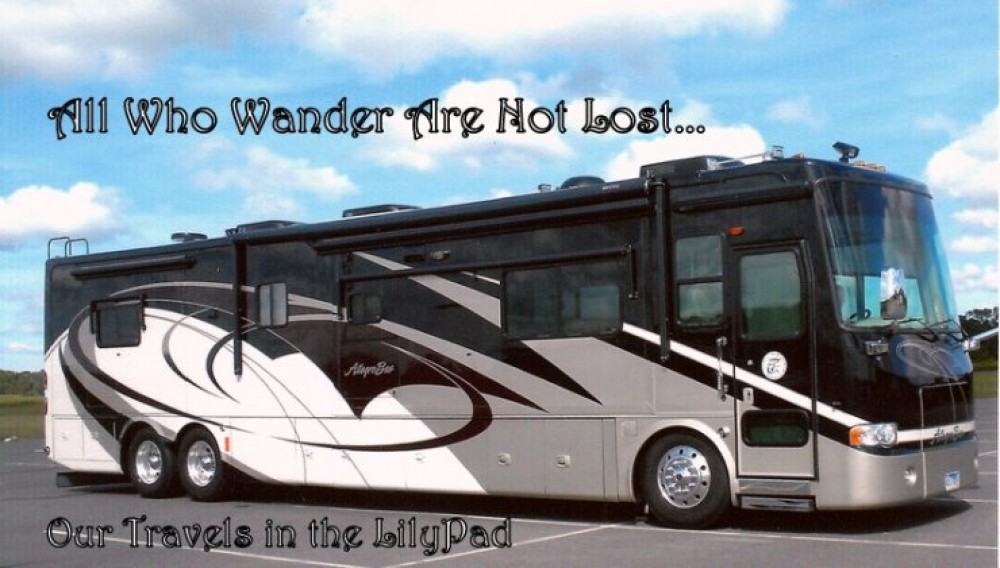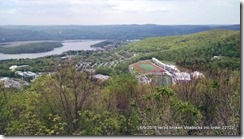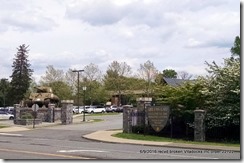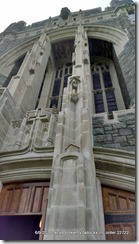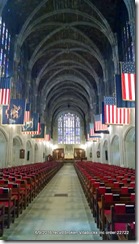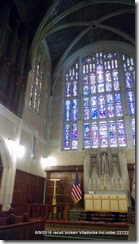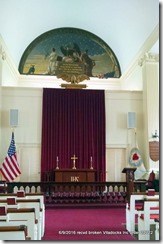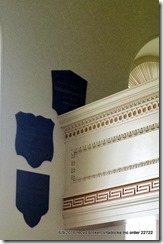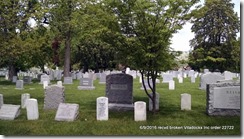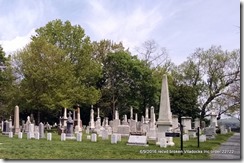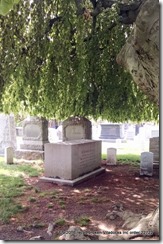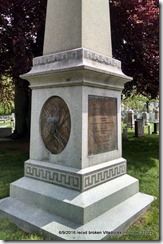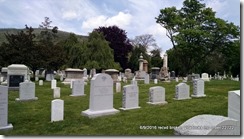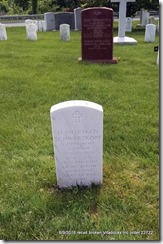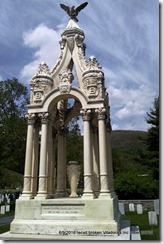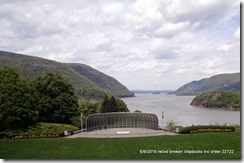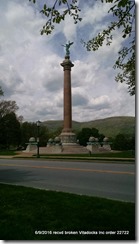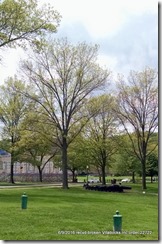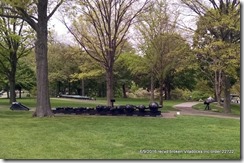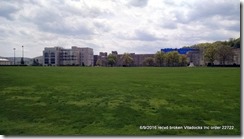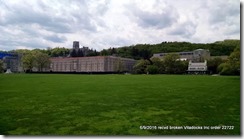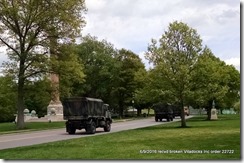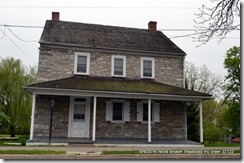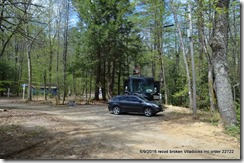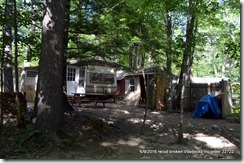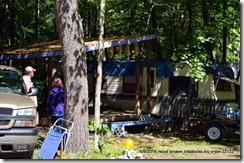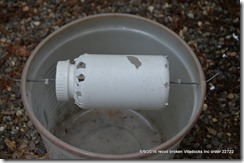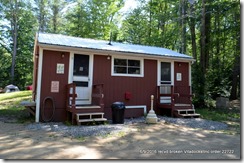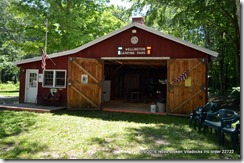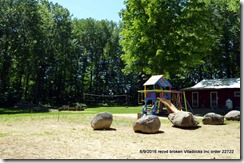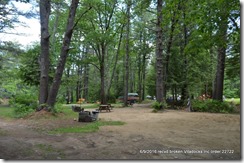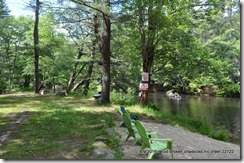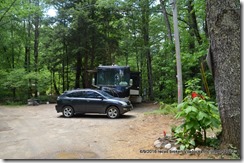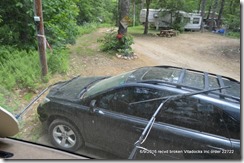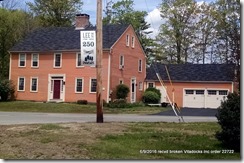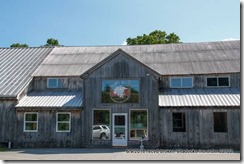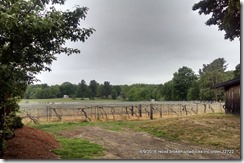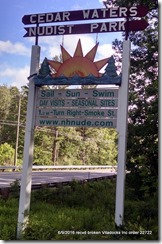Upon arrival at the only campground within an hour drive of Beacon New York, the New York City/North Newburg KOA in Newburg, we settled into our site, long level gravel, full hook-ups and friendly neighbors. The ride in was bumpy with bug swarms because of the small lake at the entrance but we are only here for two nights so full hook-ups are our only necessity. Plans are to meet up with our Texas friends for dinner tonight and the four of us will connect in the morning for a tour of West Point.
With KatieBug guarding LilyPad, we drove through rolling hills and giant oak lined roadways to the picturesque town of Beacon, NY. Blue skies, puffs of white clouds, green trees and grass, pops of color hanging from baskets and in patches on the ground, the result of Spring plantings. Multifold buildings still standing from the 1800’s, many of them carefully repurposed into shops, businesses, non-profits and café’s. We enjoyed visiting the town last year and our return evokes pleasant memories of friends and relaxation.
Located on the Eastern shore of the Hudson River, the town is a rather petite hamlet with enough to do and see within walking distance to earn the description of “cozy”. An hour from New York City, it is close enough to transit for employment but far enough away to distance oneself from big city life, big city stress and big city prices.
An outdoor paradise in seasonal weather, the town is near tree shaded hiking trails in and around Mt. Beacon Incline Railway and hike and bike paths along the Hudson. In town and along the outskirts of town, opportunity for exercise is abundant.
We arrived and met up with our Texas friends, dined out at a local restaurant and socialized after we finished eating, relaxing and chatting away the dinnertime hours, then returning to LilyPad before dusk to enjoy a quiet going-to-sleep-early evening.
Morning arrived and we were off to the Town of Highlands in Orange County New York for a tour of West Point. Founded in 1802 by Thomas Jefferson and George Washington, West Point, a.k.a. “The Point” is a military school on a 16,000 acre plot of land on the western bank of the Hudson River. Its graduates are predominantly engineers and after graduation, typically serve as Army officers. Striving for well-rounded cadets, all were expected to earn excellent grades, attend all classes and be present in church. After General Douglas MacArthur became commandant, inclusion in sports became compulsory.
West Point houses the campus of the United States Military Academy, West Point Cadet Chapel, The Old Cadet Chapel, Cemetery, Visitor Center and museum.
Our tour was partial bus ride, the balance, relaxed walking. Our guide referred to the tour as the Boot Camp Tour, meaning for us, welcome leg stretches and much needed exercise. Our first stop was the West Point Cadet Chapel.
The church serves to welcome and provide spiritual support to West Point cadets, staff and faculty. Until recently, attendance was required but there are still large numbers in attendance each service, something expected considering cadets and soldiers who enter have been, or will be, “in harm’s way”.
We boarded the bus and drove to the Old Cadet Chapel, built in 1836, the first house of worship at the Academy. Originally located near the cadet barracks, the chapel was removed from the parade grounds to be reassembled, piece by piece, in the West Point Cemetery. It was relocated in 1911 with funds raised by the cadets. The focal point of the Chapel is an impressive half circle mural above the alter titled, “Peace and War” by Robert W. Weir, Professor.
Inside, positioned in orderly lines up and down the walls, are plaques and unusual memorabilia of outstanding Generals of the Revolutionary War, George Washington being placed at the head. In the far rear, above the railing of the choir loft, is a plaque dedicated to the infamous Major General Benedict Arnold, his name defaced, the plaque showing only his rank and date of birth.
Outside were the cemetery grounds. We walked reverently through the tranquil grounds, stopping at several grave sites to hear a story about the hero buried there, a service the deceased had done for our country or an interesting piece of historical information. It was pointed out, although already noticed by most, that some graves were father and son, some father and daughter. There were even a few grandfather, son and grandson graves. One alone is sad enough but how unbearable, unimaginable and heart wrenching is the sight of three losses especially if all were taken at early ages.
The Mission Statement of the West Point Cemetery is to: “deliver the Final Salute to those members of the US Corps of Cadets, its Faculty, Staff and those West Point Graduates who have dedicated their lives in the service of this nation. We strive to commemorate and memorialize these Graduates and to care for their final resting place in perpetuity. May it be said, “Well done; Be thou at peace.”
Sylvanus Thayer, class of 1808, was a former Superintendent (1817-33) and considered to be the Father of the Military Academy. President James Monroe ordered Thayer to West Point to become superintendent of the Academy. Under his administration the Academy became the first college of engineering in the nation.
Thayer established traditions and policies still in use today at West Point. Values of honor and responsibility, strict mental and physical discipline, the demerit system, summer encampment, high academic standards and requiring cadets to maintain consistent outstanding military demeanor and appearance, all attributed to Sylvanus Thayer.
Leaving the Army in June 1863 with the rank of Colonel in the Corps of Engineers, he spent the majority of 30 years as Chief Engineer for the Boston area. He oversaw the construction of both Fort Warren and Fort Independence to defend Boston Harbor.
He died on September 1872 at his home in Braintree Massachusetts, his remains were removed from South Braintree Massachusetts and re-interred at West Point Cemetery.
In 1879 the legendary Custer statue was unveiled. George Armstrong Custer arrived at West Point in June of 1857 with 107 other cadet candidates and made the whittled down cut to 34. Making friends easily, he excelled in socialization. The rules stated that during a six month term, one hundred demerits resulted in expulsion. Our tour guide told us that Custer was rowdy as a cadet, playing jokes and pranks, earning near expulsion amounts of demerits. He would attain upwards of ninety each semester. When he had reached near the limit, he would apply himself until the new semester started, not allowing further demerits to accumulate.
Never for anything significant, the trivial offenses included trifling in ranks marching from parade (3 demerits), calling “Corporal” in a loud and boisterous voice (3 demerits), hair out of uniform at guard meeting (2 demerits), late to supper (1 demerit), throwing snowballs on barrack steps (3 demerits). Although he was smart enough to achieve high grades, he lacked the drive and discipline, no doubt why his parents thought West Point would help him improve.
Graduation nearing, his emerging personality exhibited no signs of a willingness to control his mischievous behavior and being no more disciplined, he ran up ninety-seven demerits, a record for him, in his last semester. He graduated with his class in 1861, ranking 34th in his class of 34 graduates.
After graduating, he set out to locate the Second Cavalry. Custer excelled in battlefields and had been a hugely successful leader until his last stand.
We paused at the headstones of General William Childs Westmoreland,
and H. Norman Schwarzkopf
and Major General Daniel Butterfield. When Major General Butterfield’s grave marker was completed, West Point enacted standards for size allowances of markers.
After leaving the cemetery, our bus took us to the Battle Monument overlooking the Hudson River.
In 1897, the Battle Monument was dedicated by Civil War veterans who paid for the monument through their pay and donations. Names of the officers and soldiers, 2,230 of the Regular Army, are inscribed on the monument.
Next to the monument, a grassy knoll displays an array of cannons. Those cannons planted in the ground, facing downward, were from the battles of the civil war, buried so they could never again be fired.
The parade area is exactly what it suggests…a super-sized field where the cadets march and “parade” by officers and guests in the stands.
Accepting its first female cadets in 1976, the U.S. Army recently announced that Col. Cindy Jebb will be the next U.S. Military Academy’s Dean of Academic Board, which makes her the first woman to hold this position in West Point’s history.
While we stood waiting for our bus, a convoy of Army troop trucks passed us by, loaded with Cadets leaving for Summer Maneuvers.
The United States Military Academy’s mission is to educate, train and inspire the Corps of Cadets so that each graduate is a commissioned leader of character committed to the values of Duty, Honor, Country and prepared for a career of professional excellence and service to the nation as an officer in the United States Army.
Depositing us back at the visitor center, we enjoyed a late lunch with friends. Tired and pollen impaired after the outdoor “Boot Camp Tour” we said good-by. I felt a migraine creeping up from the high pollen counts and overpowering bus bathroom deodorant odor and hoped a rest would allow us to join up again for dinner but it was not to be. John did the packing as we readied ourselves for our seasonal workamping experience in Lee New Hampshire. After nearly a month, our last day on the road.
I Love New England and its abundance of historic houses, although in my humble opinion those stately granite stone homes in Pennsylvania do give Victorian, salt box and Mansard styles a run for their money.
It is mid-week and we have arrived at our home for the next five months, Wellington Camping Park in Lee New Hampshire. I knew before accepting, this workamp position would be located in a vintage family run camp, dirt roads and homesteaded primarily by seasonal families. I was assured by the former workampers that the people were friendly, the campground was nice and the roads were not dusty. Two out of three ain’t bad. Absolutely Texas Friendly. Nice is a relative term…the entire campground is in a state of total transition. As far as dusty, my answer is given in my strongest Texas accent. “Hell yea, it’s a gigantic dusty dirt ball”.
The campground I saw in Google Maps, had the appearance of your typical trailer trash neighborhood dwellings, more closely resembling a backwoods Georgia hooch distillery camp than a family campground so expectations were met as we drove down the dusty rutty road into the camp. Two levels of small decades old trailers with handcrafted wood or metal roof coverings and wood porches, a hodgepodge of tents, trailers and motorhomes, all tucked under shade trees and along the river.
The owner, Pat Wellington, runs the family encampment with a can-do attitude. She will be in your face if you even hint of ignoring the rules. For all of her petite 5 foot frame, she is one spunky senior lady and has no intention of allowing seasonal families to slip by without paying their proper dues. The camp offers reasonable seasonal rates, recently installed 50amp hook-ups and free pump out service, free use of the paddle boat, kayaks and canoes complete with life jackets and inexpensive dry wood for campfires. Her children and grandchildren respect her as the reigning matriarch and decisions are primarily made at her judgment call.
Upgrading began just recently and she has taken on the job of removing the primitive mid-20th century “trailer trash”, cleaning out barely standing and abandoned trailers covered by blue plastic tarps and their accompanying rotted porches and decks. We see her daily out in the park carting away whatever junk she can manage to lift, then instructing the maintenance man to haul the rest to the dump.
Between her family, take-down crews and workampers, the sites are being cleared, one by one, piece by piece, hauling off dead appliances and beds, her sons using the backhoe to crush the various colors of wooden porches into kindling and the campground truck to haul it all to the dump. The family works with a Titan’s determination, all pitching in to complete whatever needs to be done to transform Wellington into a respectable 21st century seasonal campground. Several abandoned sites are on the chopping block. This one will come down next week.
This one is down to the final bare bones removal, the camper will be pulled out and sold as junk.
Currently the park is inhabited primarily by seasonal families, some living full time, some only on weekends. There are two sections of the park, one down the hill by the river (downstairs) and one up the hill near the open field (upstairs). We are downstairs. The park is a mixture of campers who have been returning here for decades, linemen workers who live on the grounds until the job ends, transient weekend campers and the three workampers.
First on the itinerary, before setting up the inside, was to ward off evil creepy crawlies that might sneak inside, chew wires, bite humans or fur babies. Armed with several bottles of granules that promised to ward off spiders, rats and rodents, I sprinkled the area. Squirts of scented oils were used as a backup in case the granules didn’t work, non-toxic sprays around the outer boundary of the motorhome to discourage insects and some fox urine on surrounding trees to discourage badgers and skunks. Fingers were crossed in hopes that anything lurking nearby was met with a fitting discouraging smell. John set up our mouse trap buckets bated with organic peanut butter. Moderately confident that we were protected, we set up camp and relaxed for the night.
Next morning our mouse trap buckets were completely stripped of peanut butter and unusually large fang marks had pierced holes in the plastic. Hmmm, probably not rodents.
We dumped the buckets and scrapped the idea of peanut butter lures for catching mice. No reason to send out invitations encouraging creatures, outfitted with big sharp teeth, to visit our motorhome.
Searching the internet we learned that this immediate area is inhabited by bear, moose, coyotes, skunks, badgers, squirrels and chipmunks. Additional menacing crawlers are ticks, ants and spiders, an overabundance of them, with flying attacks coming from mosquitos and biting gnats. Thrown into the mix are large quantities of poison oak hugging the trees, a constant generous dusting of pollen, dirt roads billowing dust and smoke from campfires giving us that “total camping experience” for our five month stay in New Hampshire. The “experience” was joyous as a scout leader with my Girl Scout daughter and Boy Scout son. As a a senior, it comes nearer to unbearable.
When John hooked up the sewer, we discovered that we did not have full hook-ups but two underground tanks. They held only enough for one “dump” of our black and grey tanks. We would need the “honey wagon” twice a week. Unexpected but survivable with careful scheduling of showers, dishwashing and clothes washing.
The bathrooms are old but serviceable, wood, plastic and screen, all in one stage or another of needing a patch or repair. When funds allow, the owner plans to build new facilities.
There is a large recreation hall attached to the upstairs bathrooms near the children’s play structure, volley ball net and horseshoe pit. It has a small kitchen area, fridge, picnic tables and a pool table inside. The walls are covered with pictures of camping families spanning more decades than I have been alive.
The camp is located on the banks of the Lamprey River, the trees provide a cooling sunscreen. Canoes, paddles, life jackets and a paddle boat are free for campers to use.
Beach chairs line the river beach area.
John made mention that “lamprey” was an evil name for our river. It wasn’t until I looked up the word “lamprey” that I added it to the list of things I could do without seeing…ever. The internet picture below is of a river lamprey. The article states that a river lamprey can’t attach itself to anything but I think I’ll skip going anywhere near the water just in case.
We were here several days before we began to understand what was expected of us. There was no training, no meeting, no welcome pot luck. We work 30 hours in five days, then have nine days off. Our alternate Workamper host is Linda, a single woman living in a small class C camper with her Yorkie mix fur baby. Charlie is the lone maintenance man who helps with removing junk from abandoned sites and does what he can to keep things repaired around the campground. John enjoys working with Charlie on projects and it provides us both with a little breathing room. I bought a hanging plant to brighten up our site and Pat bought me ground plants to enhance my little patch of color.
Good Morning Sunshine! Cough, cough, wheeze, cough, cough, wheeze…dust rises up and covers us and everything surrounding our site, multiple times a day. The site is large and roomy but sadly, we are located inches from the main road loop by which everyone must enter and exit. Our motorhome and car have a thick coating of brown dirt, mixed in with the yellow tree pollen that even the heaviest of rain storms did nothing to strip away.
Feeling grateful and thankful for “Oh Wonderful Hubby of Mine” who sprays down our road at least once a day to keep the dust quenched. So far, the dust has been mightier but we keep trying. Each morning we wake up to more dust and I have a feeling it is a losing battle.
With all that floats in the campground air, I plan to spend most of my days indoors and as many hours as possible near Portsmouth New Hampshire inhaling the cool salt sea air and cleansing my lungs.
I don’t do Spring well. My lungs object to sky high pollen counts and windy days blow pollen off trees and plants and force them into every facial opening in my head. We usually leave Texas just before Spring and follow blooming trees, grasses and flowers to our final destination, traveling for a month or longer. A maximum amount of multiple drugs offer modern medicine a shot at keeping my lungs clear but unhappily the drugs severely curtail my ability to balance. I am left with lungs that are huffing and puffing while I teeter-totter along. John kindly allows me to use him as a cane whenever we are enjoying outside activities together. I will continue to push myself to do things that are joyful, especially with the companionship of people we like or when there is a possibility of an exciting adventure. I shall remain determined to enjoy as much of the journey as possible, pushing health to the edge, but hopefully never again over. I don’t do sick well either.
My first day on the job was spent removing spider webs from all the bathroom bare wood ceilings, cleaning bathroom toilets, showers, sinks, wood floors and pulling up weeds from the horseshoe pit. John raked up leaves and cleaned off plastic campground chairs, weed whacked and helped clean toilets. After 4 straight days of pulling weeds for several hours each day in the heat, the horse shoe pit still looks like a weed patch. Another losing battle.
Our five workamping days at an end, we bought and used our first New England Groupon, a local winery tour and tasting. Driving through the town square we saw banners announcing Lee’s 250th birthday. The square is circled by well cared for and preserved early 1800’s homes.
Our Groupon was for two tours and tastings at Flag Hill Winery. The sales/tasting room is a converted 1800’s dairy barn, beautifully repurposed and restored. White wine is their premier crop but their reds were lite and easy drinking. They also make liqueur but it was somewhat sharp for my palate.
Flag Hill’s old vines are near the road we travel over each time we go for groceries.
Another nearby main road has a sign that made us both do a double take. This sleepy little town has a nudist park.
The Country Western song “What was I thinking”, plays repetitiously in the background of my brain. Music, even in my mind, calms me and helps to quell the disappointment felt at having taken another workamp position with unhealthy breathing conditions. Plans are being made for our first get-away, an escape to the seaside, complete with soothingly cool salt sea air.
Someday I will purchase a crystal ball and see if my gypsy blood can detect the negatives of future workamping choices floating through its orb before we accept. Something has got to work, asking point blank questions does not. It may be a slightly odd way of getting honest answers but I’m willing to try anything once.
Tomorrow we are off to coast of Maine! KatieBug will be resting snuggly in her travel crate, the car will be dusted and wiped down inside, we will gas up and be on our way, ready to relax and recoup. This is the fun part of travel. A new place to explore, fresh air to breathe, no dust, nothing to fix, dump or clean for three days. Yea ocean!
